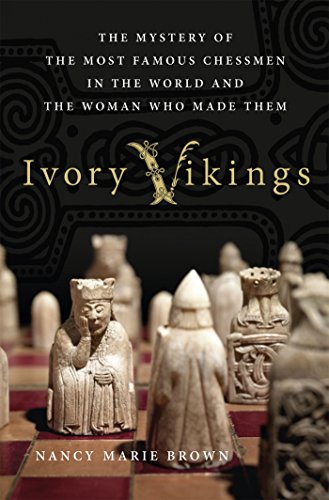
Ivory Vikings--The Mystery of the Most Famous Chessmen in the World and the Woman Who Made Them
کتاب های مرتبط
- اطلاعات
- نقد و بررسی
- دیدگاه کاربران
نقد و بررسی

June 22, 2015
Brown (Song of the Vikings) successfully crafts an Icelandic history of chess while tracing the possible movements of 92 remarkable carved figures found in the early 19th century on the Isle of Lewis in Scotland. Drawing on the intertwined cultures, local artistic abilities, and close relationships among 12th-century Norway, Iceland, Greenland, Scotland, and England, Brown connects the threads between them with her own translations of Icelandic sagas and related archaeological research. She divides the tale into sections—Rooks, Bishops, Queens, Kings, and Knights—and inserts little-known historical tidbits about the game itself. Scandinavian history buffs and chess enthusiasts will revel in the power games between would-be kings and those already enthroned, some of whom, Brown posits, may have commissioned these walrus ivory chess sets
as gifts for other kings. Other readers may find the mystery of the set’s hotly contested origins more enthralling. As for Margret the Adroit, the woman who
supposedly made them, Brown makes
the most of a saga’s sole mention of her artistic skill to support a recent and entirely plausible theory as to the pieces’ source. Though more full of conjecture than the assertive subtitle suggests, Brown’s account is nonetheless fascinating. Illus.

June 15, 2015
The investigation into the origins of the 92 ivory chessmen discovered on the Isle of Lewis in the early 1800s provides a good avenue for Brown (Song of the Vikings: Snorri and the Making of Norse Myths, 2012, etc.) to explore the rich tapestry of Icelandic and Viking history. Iceland was a primary source of walrus ivory and produced more indigenous literature than any other language save Latin in the 11th and 12th centuries. The author tells of the intriguing "dragon scale," which rates the historicity of the tales; the more dragons, trolls, ghosts, and walking dead, the less likely the accuracy of the saga. They were categorized as Family Sagas, Sagas of Ancient Times, Kings' Sagas, and Contemporary Sagas, with the Family and Contemporary scoring low on the dragon scale. Reading the medieval sagas in the original Icelandic, Brown has extra insight into the life of Iceland's golden age, and she finds frequent references to the culture of chess, royal gifts of chessmen, and actual chess matches. Chess was invented in India, taken to Persia by the mid-500s, and moved with Persian silver into the global trade routes. It was a king's game of strategy and courtly love, initially with only one king, highly outnumbered. The author shows how different pieces evolved, as the vizier became first a weak queen, and then strong, and rooks become berserks, Odin's warriors. Dating the delightfully quirky Lewis chessmen around 1200, Brown notes that their Romanesque style continued its popularity in Iceland. She is convincing in her assertion that Bishop Pall of Skalholt commissioned one of his four artisans, Margret the Adroit, to carve them. Photos of the chessmen enhance the narrative. Well-written and scholarly without being pedantic-an enlightening history of the broad influence the Vikings exerted in a very short period.
COPYRIGHT(2015) Kirkus Reviews, ALL RIGHTS RESERVED.

July 1, 2015
Throughout the ages, chess sets have provided inspiration for sculptors to create thematically linked miniature works of art. One of the oldest and most famous examples of this is the Lewis chessman, which was discovered in Scotland. These old sets appear to have Viking designs and are carved from walrus ivory. Here, Viking historian Brown (Song of the Vikings) lays out the various competing theories about their origin and presents a cogent argument that a woman referred to in one of the sagas as Margret the Adroit may have created these sets in Iceland in 1,200 CE. Along the way, we learn a great deal about the Vikings as raiders and traders, and their impact on world history. To those of us accustomed to seeing the map of the world in Mercator projection, it is illuminating to realize how close together locations in the high latitudes are to one another. Thus, Norway, Scotland, Iceland, and even Greenland were connected for this intrepid, seafaring people. VERDICT An intriguing work that should find a readership among history lovers.--Harold D. Shane, mathematics emeritus, Baruch Coll. Lib., CUNY
Copyright 2015 Library Journal, LLC Used with permission.

Starred review from September 1, 2015
In the early 1800s, 92 game pieces, most of them chessmen, were discovered on a sandbank in Scotland. The ornate, tiny pieces (the tallest is about four inches), called the Lewis chessmen, were remarkably well preserved, considering they were buried some 600 years ago. Brown, working in the style of a literary detective, puts together a history of these astonishingly gorgeous pieces, carved most likely by a woman, Margret the Adroit of Iceland. But as Brown also notes, history is incomplete, and she fills its empty squares with pieces of our own imagination, pulling from the workssome archaic, some obscure, many controversialof archaeologists, historians, and forensics experts as well as Viking sagas. The book contains a map showing how landmasses connected way back when, adding to the mystery, and chapters, named for the found chess pieces, begin with full-page photos of these remarkable, priceless objects. The Rooks, for example, shows a wide-eyed, sword-wielding character biting his shield, his crooked teeth grasping it firmly. This book is a delight for chess players, of course, but also for gamers of all sorts as well as anyone interested in the intricacies of the provenance of art and in endlessly fascinating minutiaethe strength and uses of walrus skin, how to carve walrus ivory, and so much more.(Reprinted with permission of Booklist, copyright 2015, American Library Association.)

























دیدگاه کاربران